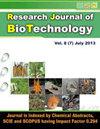纳米二氧化钛颗粒对 Eudrilus eugeniae 的影响:毒理学研究
IF 0.2
Q4 BIOTECHNOLOGY & APPLIED MICROBIOLOGY
引用次数: 0
摘要
纳米技术的应用日益广泛,这意味着纳米材料将不可避免地进入环境。因此需要生态毒理学数据,以便进行适当的风险评估。纳米粒子(NPs)的尺寸小于 100 纳米,表面积较大,因此具有更强的反应能力。由于对人体细胞的反应性更强,纳米粒子更容易侵入人体,其毒性也比块状材料更大。此外,人们还对纳米粒子的生态毒理学进行了研究,旨在评估纳米粒子对生态系统的有害影响。二氧化钛(TiO2)纳米粒子被广泛应用于防晒产品和自清洁涂料。在这些商业产品的生命周期中,氮氧化物可能会释放到环境中,对生态系统造成威胁。特别是,TiO2 NPs 已被证明具有毒性作用,并能抑制土壤中重要微生物的生长。本研究主要探讨了 TiO2 纳米粒子对 Eudrilus eugenia 的毒理学和组织病理学影响,旨在揭示纳米粒子对土壤生物的潜在危害。该研究评估了不同浓度二氧化钛对蚯蚓的毒性、生物量变化、产茧量和死亡率。结果表明,二氧化钛纳米粒子会对蚯蚓的生存和繁殖产生亚致死效应,并且纳米粒子会在蚯蚓组织中积累。该研究强调了考虑纳米粒子与土壤生物相互作用的必要性。本文章由计算机程序翻译,如有差异,请以英文原文为准。
Impact of Titanium Dioxide Nanoparticles on Eudrilus eugeniae: A Toxicological Study
The increasing use of nanotechnology means that nanomaterials will inevitably enter the environment. Eco-toxicological data are therefore required so that adequate risk assessments can be carried out. Nanoparticles (NPs) exhibit greater reactivity as their sizes, less than 100nm size, are so small that their surface area is larger. The NPs can intrude into human body more easily and are more toxic than bulk material due to increased reactivity to cells in the body. Further, investigations on the ecotoxicology of NPs have also been conducted, aiming to assess NP’s harmful effects to the ecosystem. NPs of titanium dioxide (TiO2) are widely used in sun care products as well as in self-cleaning coatings. During the life cycle of these commercial products, NPs may be released into the environment and become a threat to ecosystems. Particularly, TiO2 NPs have been shown to have toxic effects and can inhibit the growth of essential soil microorganisms. This study focused on the toxicological and histopathological effects of TiO2 nanoparticles on Eudrilus eugenia, aiming to shed light on the potential hazards posed by nanoparticles to soil organisms. This study assessed the toxicity, biomass change, cocoon production and mortality rate of earthworms under various concentrations of titanium dioxide. The results showed that TiO2 nanoparticles could lead to sublethal effects on earthworm survival and reproduction and the nanoparticles were accumulated in earthworm tissues. The study emphasized the need to consider nanoparticle interactions with soil organisms.
求助全文
通过发布文献求助,成功后即可免费获取论文全文。
去求助
来源期刊

Research Journal of Biotechnology
BIOTECHNOLOGY & APPLIED MICROBIOLOGY-
CiteScore
0.60
自引率
0.00%
发文量
192
期刊介绍:
We invite you to contribute Research Papers / Short Communications / Review Papers:
-In any field of Biotechnology, Biochemistry, Microbiology and Industrial Microbiology, Soil Technology, Agriculture Biotechnology.
-in any field related to Food Biotechnology, Nutrition Biotechnology, Genetic Engineering and Commercial Biotechnology.
-in any field of Biotechnology related to Drugs and Pharmaceutical products for human beings, animals and plants.
-in any field related to Environmental Biotechnolgy, Waste Treatment of Liquids, Soilds and Gases; Sustainability.
-in inter-realted field of Chemical Sciences, Biological Sciences, Environmental Sciences and Life Sciences.
-in any field related to Biotechnological Engineering, Industrial Biotechnology and Instrumentation.
-in any field related to Nano-technology.
-in any field related to Plant Biotechnology.
 求助内容:
求助内容: 应助结果提醒方式:
应助结果提醒方式:


